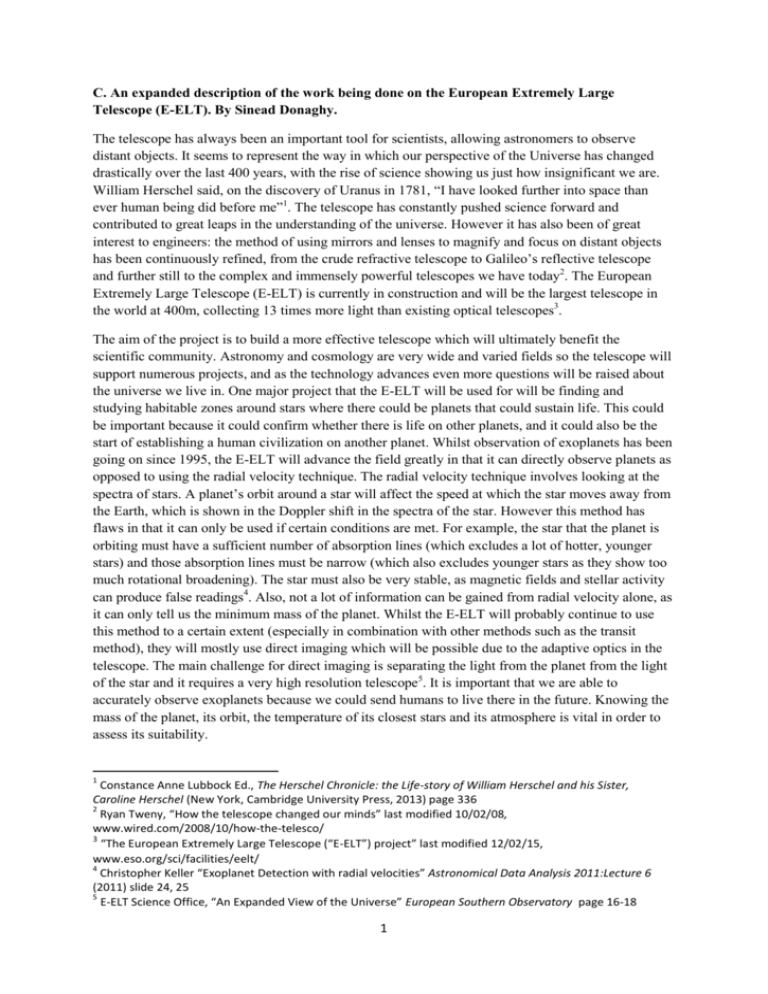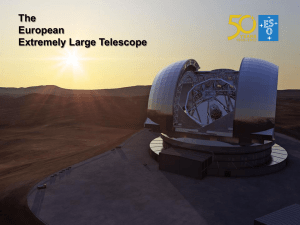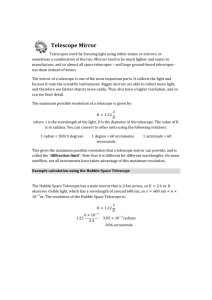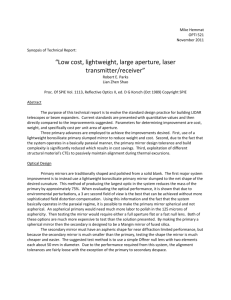Sinead Donaghy
advertisement

C. An expanded description of the work being done on the European Extremely Large Telescope (E-ELT). By Sinead Donaghy. The telescope has always been an important tool for scientists, allowing astronomers to observe distant objects. It seems to represent the way in which our perspective of the Universe has changed drastically over the last 400 years, with the rise of science showing us just how insignificant we are. William Herschel said, on the discovery of Uranus in 1781, “I have looked further into space than ever human being did before me”1. The telescope has constantly pushed science forward and contributed to great leaps in the understanding of the universe. However it has also been of great interest to engineers: the method of using mirrors and lenses to magnify and focus on distant objects has been continuously refined, from the crude refractive telescope to Galileo’s reflective telescope and further still to the complex and immensely powerful telescopes we have today2. The European Extremely Large Telescope (E-ELT) is currently in construction and will be the largest telescope in the world at 400m, collecting 13 times more light than existing optical telescopes3. The aim of the project is to build a more effective telescope which will ultimately benefit the scientific community. Astronomy and cosmology are very wide and varied fields so the telescope will support numerous projects, and as the technology advances even more questions will be raised about the universe we live in. One major project that the E-ELT will be used for will be finding and studying habitable zones around stars where there could be planets that could sustain life. This could be important because it could confirm whether there is life on other planets, and it could also be the start of establishing a human civilization on another planet. Whilst observation of exoplanets has been going on since 1995, the E-ELT will advance the field greatly in that it can directly observe planets as opposed to using the radial velocity technique. The radial velocity technique involves looking at the spectra of stars. A planet’s orbit around a star will affect the speed at which the star moves away from the Earth, which is shown in the Doppler shift in the spectra of the star. However this method has flaws in that it can only be used if certain conditions are met. For example, the star that the planet is orbiting must have a sufficient number of absorption lines (which excludes a lot of hotter, younger stars) and those absorption lines must be narrow (which also excludes younger stars as they show too much rotational broadening). The star must also be very stable, as magnetic fields and stellar activity can produce false readings4. Also, not a lot of information can be gained from radial velocity alone, as it can only tell us the minimum mass of the planet. Whilst the E-ELT will probably continue to use this method to a certain extent (especially in combination with other methods such as the transit method), they will mostly use direct imaging which will be possible due to the adaptive optics in the telescope. The main challenge for direct imaging is separating the light from the planet from the light of the star and it requires a very high resolution telescope5. It is important that we are able to accurately observe exoplanets because we could send humans to live there in the future. Knowing the mass of the planet, its orbit, the temperature of its closest stars and its atmosphere is vital in order to assess its suitability. 1 Constance Anne Lubbock Ed., The Herschel Chronicle: the Life-story of William Herschel and his Sister, Caroline Herschel (New York, Cambridge University Press, 2013) page 336 2 Ryan Tweny, “How the telescope changed our minds” last modified 10/02/08, www.wired.com/2008/10/how-the-telesco/ 3 “The European Extremely Large Telescope (“E-ELT”) project” last modified 12/02/15, www.eso.org/sci/facilities/eelt/ 4 Christopher Keller “Exoplanet Detection with radial velocities” Astronomical Data Analysis 2011:Lecture 6 (2011) slide 24, 25 5 E-ELT Science Office, “An Expanded View of the Universe” European Southern Observatory page 16-18 1 The E-ELT could also be part of the effort to understand dark energy and explain why the universe is expanding at the rate it is. Redshift is an indicator of the expansion of the universe, and the E-ELT will be able to measure it much more accurately and therefore measure the effect of dark energy. The size of the E-ELT allows it to collect much higher resolution data and this has a number of applications and is the main appeal of the project. One project this will be important in is the nuclear dating of stars. This will tell scientists much more about the life cycle of stars which will in turn give them a greater understanding of the processes taking place within galaxies and how that shapes their evolution6. Nuclear dating or nucleocosmochronometry is very useful for distant stars whose ages cannot be determined any other way and it uses the idea of nuclear decay to work out the age of a star by measuring the abundance of long-lived radioactive isotopes such as 232Th (mean lifetime 20.3 billion years) and 238U (mean lifetime 6.5 billion years)7. This method has disadvantages, such as high uncertainties due to systematic errors, however the use of the E-ELT will overcome one of the major disadvantages of this method being limited to brighter stars as very high resolution spectra must be used. Use of this method will allow the ages of many stars to be calculated to help us understand how the Milky Way has changed and evolved. These are just a few of the projects that will benefit from using the E-ELT, there are many more that will progress science and help scientists to understand our universe even more. The E-ELT is being built because its design will be of benefit to science. It is different from other telescopes firstly in terms of scale: it will have a 39m primary mirror, which its designers claim will “provide images 16 times sharper than the Hubble Space Telescope”. Secondly, it will have five main mirrors which will increase the quality of the images. The telescope will use Nasmyth foci, like many other large telescopes, in order to increase their mobility. It means that the main structure can be mounted on a permanent platform but the Nasmyth focal surface can be attached on an altazimuth mount that needs only a small Figure 1 range of movement to cover the whole sky8. In the case of the E-ELT, it is the fifth mirror that directs the light to the Nasmyth focal point. Figure 19 shows the direction of light as it enters the telescope. As it enters, it is reflected by the primary mirror (M1) towards the secondary mirror (M2). The convex secondary mirror reflects the light through a hole in the quaternary mirror (M4) and towards the tertiary mirror (M3) which is located in the centre of the primary mirror, within the 11.1m obstruction. The tertiary mirror reflects the light into the adaptive optics system which is made up of the quaternary and fifth mirror. These mirrors can change their shape in order to correct distortion caused by the Earth’s atmosphere, which can be measured using a very bright reference star. This means that telescopes that use this system can produce images that are almost as sharp as those taken in space. The quaternary mirror is inclined at a 7.74 degree 6 E-ELT Science Office, “An Expanded View of the Universe” page 16-18 David Soderblom, “The ages of stars” Annual Reviews of Astronomy and Astrophysics pages 10-11 8 David Darling “Nasmyth Focus” The Encyclopaedia of Science, www.daviddarling.info/encyclopedia/N/ Nasmyth_focus.html 9 Figure 1: Nasmyth configuration, “E-ELT Optical Design” last modified 16/06/11, www.eso.org/sci/facilities/eelt/telescope/design/ 7 2 angle and directs the light to the fifth mirror which does the final image correction and then reflects the light towards the Nasmyth focus. An alternative to the Nasmyth focus would be a Coude focus (see figure 4). They are similar, but a Coude focus is at a fixed point which differs from the Nasmyth focus which has a focal point that is separate from the main telescope but which moves with it. Coude focuses give a narrower field of view10. The concave primary mirror (M1) has been focused on a lot in the media due to its huge diameter of 39m and a radius of curvature of 69m. As mentioned before, it has an 11.1m obstruction in the centre (where the tertiary mirror is). It is made up of 798 hexagonal segments that are grouped into six sectors each with 133 segment ‘families’- see figure 211. There is a 7th segment in each family that Figure 3 can be used when one of the segments needs to be recoated. The segments’ coating is what makes them reflective, and they have to be recoated every 18 months therefore there must be constant rotation of segments with 1 or 2 being recoated every day. Each segment is made of polished glass (or glass-ceramic substrate) and has to have a surface roughness of less than 2 nanometres, making it an extremely sophisticated piece of engineering12. When all of the 789 segments are put together, position actuators allow each segment to be moved slightly to change the shape of the entire mirror, in order to correct errors: it is the position actuators that provide the high resolution of the final image. The main causes of error are the wind and vibrations from all the machinery in the telescope. There will be three actuators under each segment, controlling three planes of movement. The actuators have two position stages, the first is a Voice Coil Actuator (VCA) which uses a magnetic field and a coil of wire to produce a force proportional to the current supplied. This uses the Lorentz Force principle: F=q(E+v×B) which determines the size of the force produced by the VCA13. This design is suitable to for very accurate movements in short travel ranges. The second stage is based on a Brushless DC Motor (BLDC). A DC motor typically uses permanent, stationary magnets (the stator) and a spinning armature (the rotor). The amature contains an electromagnet which when spinning, induces a magnetic field. Brushes continuously change the polarity of the electromagnet in order to keep it spinning. However in a BLDC, which are more efficient, the magnets are the rotor and the electromagnet is the stator. A computer then charges the Figure 2 electromagnet, giving superior control and smoother movement compared to mechanical brushes14. The BLDC contrasts the VCA in that it has a large stroke range and can move the segment closer to the required position15. A gear box is attached to the motor to 10 “The Coude Focus” retrieved 11/02/15, mthamilton.ucolick.org/public/tele_inst/3m/coude.html Figure 2: Primary Mirror Segmentation Pattern, M. Cayrel, “E-ELT Optomechanics: overview” European Southern Observatory (2012), page 2 12 M. Cayrel, “E-ELT Optomechanics: overview” page 2, 3 13 Bill Black, Mike Lopez, Anthony Morcos, “Basics of Voice Coil Actuators” page 1 14 Marshall Brain “How does a brushless electric motor work?” last modified 15/12/08, electronics.howstuffworks.com/brushless-motor.htm 11 3 reduce the power consumption which is important as if a lot of power is used, a lot of heat will be dissipated directly under the mirror segments. Ideally, the power consumption of each position actuator will be around 0.6 W16. The prototype currently being developed and tested (see figure 317) is promising in terms of both accuracy and power usage. Cerro Armazones, a mountain in Chile, has been selected as the site for the E-ELT. Figure 418 is a map of the area, labelling the Paranal observatory site as well as the E-ELT. The site selection process has been going on for years, and several sites have been considered, including Figure 4 Roque de los Muchachos in Canary Islands, Cerro Tolonchar, Cerro Ventarrones and Vizcachas in Chile19. Mountains are an obvious choice when building a ground based telescope as their high altitude helps to minimise the distortion caused by the atmosphere. In addition, mountains are often far away from towns and cities so there is less light pollution. The parameters that were to measured were “Optical turbulence, wind velocity, outer scale, seeing, isoplanatic angle, coherence time, extinction, dust, cloud cover, humidity, precipitable water vapor, sky emission, sky darkness, light pollution, soil properties and seismicity”20. A number of instruments were used to measure all of these, for example the G-SCIDAR technique. SCIDAR stands for SCIntillation Detection And Ranging and the technique involves imaging the scintillation patterns of double stars using very low exposure. Average autocorrelation function can be calculated from that, using a computer algorithm, has peaks which provide information about the various turbulent layers. Generalised- SCIDAR differs from classical in that it is able to tell us about layers closer to the ground and the optical atmospheric turbulence, including the wind profile. This can in turn give us information about the parameters: seeing, coherence lengths and time of the wave fronts and isoplanatic angles21. There are three main layers of turbulence that can affect the quality of images a telescope produces: the free atmosphere, the atmospheric boundary layer and turbulence around the telescope dome. G-SCIDAR was used at a number of the proposed sites where there were already existing observatories with the correct infrastructure. In addition to the issues regarding the quality of the images that could be procured at that site, the Site Selection Advisory Committee also had to think about the construction cost and schedule as certain sites will be easier to access and closer to where the parts of the telescope will be produced therefore the transport costs will be less and it will be quicker to build. Also, although the site would ideally avoid light 15 A. Jimenez et al. “Design of a prototype position actuator for the primary mirror segments of the European Extremely Large Telescope” Ground based and airborne telescopes (2010) page 1 16 M. Dimmler et al. “E-ELT M1 Test Facility” Ground based and airborne telescopes (SPIE, 2012) Page 5 17 Figure 3: M1 Position Actuator Prototype, M. Cayrel, “E-ELT Optomechanics: overview” page 5 18 Figure 4: artists impression of the land around E-ELT and VLT “ESO and Chile sign agreement on E-ELT” retrieved 14/02/15, www.eso.org/public/news/eso1139/ 19 “E-ELT site” last modified 15/07/11, www.eso.org/sci/facilities/eelt/site/index.html 20 J. Vernin, C. Mun˜oz-Tun˜on , M. Sarazin “E-ELT site characterization status” European Southern Observatory (2004) page 3 21 H. Ramió et al. “Cute-SCIDAR at Paranal for E-ELT Site Characterisation” Telescopes and Instrumentation (2008) page 29 4 pollution be being built away from civilisation, but where observatory staff will live should be considered, as well as access to water and electricity. The telescope could require in excess of 10MW of power so there must be grids capable of providing that22. The E-ELT will have very sophisticated instruments. As the telescope is still in the process of being designed and built, the instruments that are eventually used will probably be much more advanced than those being considered at the moment because of the fast pace of scientific and technological advancement. The procurement of the main instruments will begin in 201523. The ELT-PCS is one of the instruments that will require very new technology. It consists of a planetary camera which will be used to take high quality images, specifically of exoplanets like Earth that could be considered for terraforming and human habitation in the future. It also has a spectrograph which is an instrument used to separate and measure the different wavelengths in Electromagnetic radiation. The relative amounts of each type of EM radiation can then be determined and that information analysed. Most exoplanets would be detected using methods such as radial velocity, but the PCS will allow them to be observed using visible light or infrared wavelengths in order to learn more about an exoplanet, such as if it is rocky or if it has water24. It is one of seven instruments that will be in the E-ELT, six of which have already been determined with space for one more instrument whose purpose will be determined closer to the time of construction. The E-ELT is expected to be operational in 2024, a mere 9 years away, and its impact of the scientific community will undoubtedly be very significant. From observing exoplanets to dark matter, the uses of this telescope are vast. It’s incredibly complex design is a testimony to the creativity, innovation and far-reaching impact of modern engineering. The E-ELT is at the forefront of science and engineering, with technology such as adaptive and active optics, cryogenic bearings, real time processors and planetary cameras. Whilst the advancement of science is the telescope’s priority, society and industry will also benefit from the spin-off technologies. The E-ELT and other projects like it are pushing science forward and the progress that has already been made is incredible. Bibliography Constance Anne Lubbock Ed., The Herschel Chronicle: the Life-story of William Herschel and his Sister, Caroline Herschel (New York, Cambridge University Press, 2013) Ryan Tweny, “How the telescope changed our minds” [www.wired.com/2008/10/how-the-telesco/] retrieved 23/01/15 “The European Extremely Large Telescope (“E-ELT”) project” last modified 12/02/15 [http://www.eso.org/sci/facilities/eelt/] retrieved 23/01/15 Christopher Keller “Exoplanet Detection with radial velocities” Astronomical Data Analysis 2011:Lecture 6 (2011) [http://home.strw.leidenuniv.nl/~keller/Teaching/ADA_2011/ADA_2011_L06_Exoplanets .pdf] retrieved 11/02/15 22 “E-ELT site” last modified 15/07/11, www.eso.org/sci/facilities/eelt/site/index.html “E-ELT Instrumentation” last modified 27/01/15, www.eso.org/sci/facilities/eelt/instrumentation/ 24 Markus Kasper, Christophe Verinaud, Dimitri Mawet “Roadmap for PCS, the Planetary Camera and Spectrograph for the E-ELT” (2013) page 2 23 5 E-ELT Science Office, “An Expanded View of the Universe” European Southern Observatory [https://www.eso.org/public/archives/brochures/pdfsm/brochure_0025.pdf] retrieved 11/02/15 David Soderblom, “The ages of stars” Annual Reviews of Astronomy and Astrophysics [http://arxiv.org/pdf/1003.6074.pdf ] retrieved 26/01/15 David Darling “Nasmyth Focus” The Encyclopaedia of Science [http://www.daviddarling.info/encyclopedia/N/Nasmyth_focus.html] retrieved 11/02/15 “E-ELT Optical Design” last modified 16/06/11 [http://www.eso.org/sci/facilities/eelt/telescope/design/] retrieved 11/02/15 “The Coude Focus” [http://mthamilton.ucolick.org/public/tele_inst/3m/coude.html] retrieved 11/02/15 M. Cayrel, “E-ELT Optomechanics: overview” European Southern Observatory (2012) [http://www.eso.org/sci/libraries/SPIE2012/8444-69.pdf] retrieved 22/02/15 Bill Black, Mike Lopez, Anthony Morcos, “Basics of Voice Coil Actuators” [http://www.acmmagnetics.com/acm/pdfs/15-BasicsOfVCMs.pdf] retrieved 22/02/15 Marshall Brain “How does a brushless electric motor work?” last modified 15/12/08 [http://electronics.howstuffworks.com/brushless-motor.htm] retrieved 22/02/15 A. Jimenez, E. Morante, t. Viera, M nunez, M Reyes “Design of a prototype position actuator for the primary mirror segments of the European Extremely Large Telescope” Ground based and airborne telescopes (2010) [http://spie.org/Publications/Proceedings/Paper/10.1117/12.857158] retrieved 22/02/15 “ESO and Chile sign agreement on E-ELT” [http://www.eso.org/public/news/eso1139/] retrieved 14/02/15 M. Dimmler, J. Marrero, S. Leveque, P. Barriga, B. Sedghi, M. Mueller “E-ELT M1 Test Facility” Ground based and airborne telescopes (2012) [http://proceedings.spiedigitallibrary.org/proceeding.aspx?articleid=1361220] retrieved 22/02/15 “E-ELT site” last modified 15/07/11 [http://www.eso.org/sci/facilities/eelt/site/index.html] retrieved 17/02/15 J. Vernin, C. Mun˜oz-Tun˜on , M. Sarazin “E-ELT site characterization status” European Southern Observatory (2004) [http://www.vt-2004.org/sci/libraries/SPIE2008/7012-64.pdf] retrieved 17/02/15 Héctor Vázquez Ramió, Marcos Reyes, José Miguel Delgado, Elvio Hernández, Miguel Núñez Cagigal, Jesús J. Fuensalida, Gianluca Lombardi, Frédéric Derie, Julio Navarrete, Marc Sarazin “Cute-SCIDAR at Paranal for E-ELT Site Characterisation” Telescopes and Instrumentation (2008) [https://www.eso.org/sci/publications/messenger/archive/no.132-jun08/messenger-no132-29-31.pdf] retrieved 22/02/15 “E-ELT Instrumentation” last modified 27/01/15 [www.eso.org/sci/facilities/eelt/instrumentation/] retrieved 22/02/15 Markus Kasper, Christophe Verinaud, Dimitri Mawet “Roadmap for PCS, the Planetary Camera and Spectrograph for the E-ELT” (2013) [http://ao4elt3.arcetri.astro.it/proceedings/fulltext_12804.pdf] retrieved 22/02/15 6





